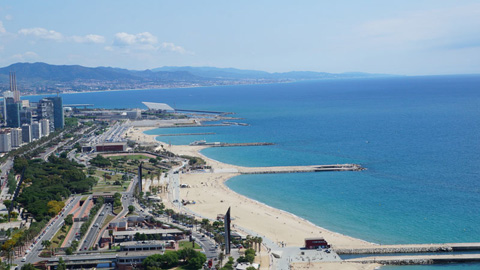Treatment plants reduce contamination around Barcelona's coastline

13/01/2017
A group of researchers from the Institute of Marine Sciences (ICM) of the Spanish National Research Council (CSIC) in Barcelona, in collaboration with the Catalan Water Agency and the UAB, has analysed the heavy metal contamination of the sediments near the coastline located between the Besòs River mouth and the Barceloneta beach. The research has revealed a drastic fall in contamination levels during the 1990s.
The study, led by ICM-CSIC research lecturer Albert Palanques, was recently published in the journal Science of the Total Environment. Participating in the research were also Laura López, Jorge Guillén and Pere Puig (ICM-CSIC), Pere Masqué from ICTA-UAB and the Department of Physics of the Universitat Autònoma de Barcelona (UAB).
Industrial and Urban Contaminants
The contamination of heavy metals in the marine environment can be analysed systematically in different countries in order to assess its impact and take the necessary corrective measures. These contaminants, mainly originating from industrial and urban areas, grew in presence along the Barcelona coastline during the 20th century.
The research analysed contamination levels of mercury, chromium, zinc, lead, cadmium and copper in superficial sediments. To do so, samples were taken from the same control points every year from 1987 to 2008, as well as cores (cylindrical samples) of sediments accumulated in the past century. The analyses of samples collected from different depths allows obtaining information of the historical evolution. And so the results have shown that the maximum levels of contamination existed between the 1970s and 1980s, while there was a drastic fall in levels in the 1990s.
The analysis of samples taken in 1987 revealed concentrations of mercury reaching up to 490 times normal levels. In the case of lead and cadmium, levels reached 40 times higher than normal values, and 17 times higher in the case of zinc, chromium and copper.
Changes After the 1990s
Contrarily, the accumulated sediment samples collected during the decade of the 1990s revealed that maximum levels of mercury and cadmium ranged from 20 to 30 times higher; and the levels of zinc, chromium, lead and copper were only 5 to 12 times higher.
That represents a very notable reduction in heavy metal contamination levels in the sediments of the area studied after the 1990s, which implies that the Besòs River and city collectors were transporting much less contamination towards the sea.
Effectiveness of Corrective Measures
Researchers attribute the decrease in contamination to the implantation of regulatory laws and to the construction and operation, starting in 1979, of water treatment plants for the Besòs River.
There are currently 24 wastewater treatment plants along the basin which treat over 840,000 cubic metres of water a day, according to data from the Catalan Water Agency, before the river runs into the ocean. Other positive contamination-reducing factors must also be added, such as environmental restoration and the construction of marshes in the 1990s; urban changes which removed heavy industry from near the coastline, before the 1992 Olympic Games; and the implementation of the EU Water Framework Directive in 2000 which represented the incorporation of highly rigorous plans for the monitoring of water and water treatment measures.
Nevertheless, scientists warn that the levels of heavy metal in the area, albeit lower and posing no threat to human bathing, must be further reduced and maintained at low levels.
This means that the measures applied until now will possibly need to be complemented. The scientists affirm that there is a need to maintain and improve both water and sediment quality by finding more effective solutions for episodes of torrential rain, when the volume of water being treated surpasses the capacity of the treatment plants.
Precisely through the River Basin Management Plan (2016-21 period), passed this past 3 January, over 26 million Euros will be destined to reduce the impact of unitary systems.
Original article:
Palanques, A., et al., "Decline of tracemetal pollution in the bottomsediments of the Barcelona City continental shelf (NW Mediterranean)", Sci Total Environ (2016).